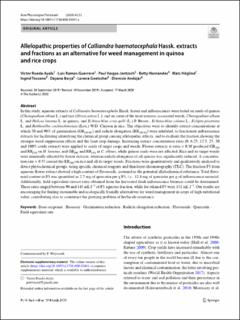| dc.description.abstract | In this study, aqueous extracts of Calliandra haematocephala Hassk. leaves and inflorescences were tested on seeds of quinoa (Chenopodium album L.) and rice (Oryza sativa L.), and on some of the most noxious-associated weeds, Chenopodium album L. and Holcus lanatus L. in quinoa, and Echinochloa crus-galli (L.) P. Beauv., Echinochloa colona L., Eclipta prostrata L. and Rottboellia cochinchinensis (Lou.) W.D. Clayton in rice. The objectives were to identify extract concentrations at which 50 and 90% of germination (GR[50,90]) and radicle elongation (RR[50,90]) were inhibited, to fractionate inflorescence extracts for facilitating identifying the chemical group causing allelopathic effects, and to evaluate the fraction showing the stronger weed suppression effects and the least crop damage. Increasing extract concentration rates (0, 6.25, 12.5, 25, 50 and 100% crude extract) were applied to seeds of target crops and weeds. Flower extracts at rates <0.30 produced GR[50] and RR[50] on H. lanatus, and GR[90] and RR[90] in C. album, while quinoa seeds were not affected. Rice and its target weeds were minimally affected by flower extracts, whereas radicle elongation of all species was significantly reduced. A concentration rate >0.52 caused the RR[50] on rice and all its target weeds. Fractions were quantitatively and qualitatively analysed to detect phytochemical groups, using specific chemical reagents and thin-layer chromatography (TLC). The fraction F3 from aqueous flower extract showed a high content of flavonoids, assumed as the potential allelochemical substance. Total flavonoid content in F3 was quantified as 2.7 mg of quercetin per g F3, i.e., 12.8 mg of quercetin per g of inflorescence material. Additionally, field equivalent extract rates obtained from the harvested fresh inflorescence biomass could be determined. These rates ranged between 90 and 143 mL l−1 of F3 aqueous fraction, while for ethanol F3 were 131 mL l−1. Our results are encouraging for finding sustainable and ecologically friendly alternatives for weed management in crops of high nutritional value, contributing also to counteract the growing problem of herbicide resistance. | en_US |

